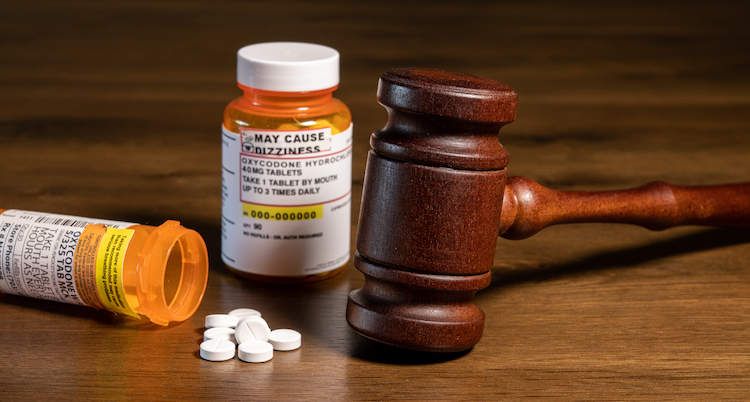Opioid plaintiffs in $50B suit failed to prove a public nuisance, judge tentatively rules

Image from Shutterstock.
A lawsuit seeking to hold drug companies liable for the opioid crisis must fail because the plaintiffs didn’t show that false and misleading marketing caused an increase in medically inappropriate prescriptions, a California judge has ruled in a tentative decision.
Judge Peter J. Wilson of Orange County, California, issued the tentative ruling Monday after having a Zoom bench trial to determine liability for an alleged public nuisance, report Reuters and NPR.
The defendants included Johnson & Johnson, Teva Pharmaceutical Industries, Endo International and AbbVie Inc.’s Allergan unit.
The decision is the first trial win for any drug companies in opioid litigation, according to Reuters. More than 3,300 lawsuits have been filed by state and local governments over the opioid crisis. In the only other case that went to trial, an Oklahoma judge found Johnson & Johnson liable for $465 million. Johnson & Johnson is appealing.
Reuters also noted that Johnson & Johnson and the three largest drug distributers are working on a proposed $26 billion settlement in thousands of cases against them. Purdue Pharma, a maker of OxyContin, has also agreed to a settlement valued at more than $10 billion.
The plaintiffs in the California case had sought $50 billion in abatement costs, according to prior coverage by Law.com.
Four local governments suing on behalf of the people of California had argued that they could prove a public nuisance by showing false and misleading marketing, followed by an increase in opiate prescriptions. They had argued that there was no need to provide evidence about how many prescriptions were medically necessary and how many were medically unnecessary.
In closing arguments, Fidelma Fitzpatrick, a partner at Motley Rice, had argued that the defendants had the burden of providing those numbers, according Law.com. She also argued that drug companies promoted opioids for uses that had not been approved by the federal government.
Wilson put the burden on the plaintiffs. Even if any false marketing caused an increase in opioid prescriptions, there is no public nuisance unless the prescriptions were medically inappropriate, he wrote.
The social utility of medically appropriate prescriptions outweighs the gravity of harm they inflict, a determination made by the federal government and the California legislature, Wilson said. In such cases, the alleged harm isn’t unreasonable and can’t be enjoined, he said. The plaintiffs “have failed to prove the ‘unreasonable’ element of public nuisance,” he wrote.
Wilson said the U.S. Food and Drug Administration had approved opioid medications after determining that the risks outweighed the benefits. In addition, California lawmakers passed a Pain Patient’s Bill of Rights in 1997 that said patients who suffer from severe intractable pain have the right to choose opiate medications.
Even if he could infer that misleading marketing caused an increase in inappropriate prescriptions, Wilson said, there is no evidence showing whether and how much the volume of such prescriptions contributed to a public nuisance.
The plaintiffs had relied on a California appellate decision involving lead paint, People v. ConAgra Grocery Products Co. But there is no appropriate indoor use for lead paint and no reason in that case to distinguish between marketing that resulted in proper versus improper uses, Wilson said.
Wilson also found that training and sales materials used by drug companies did not contain statements that would constitute false advertising or unlawful business practices.
The suit was filed for the people of California by three counties and one city in the state.



